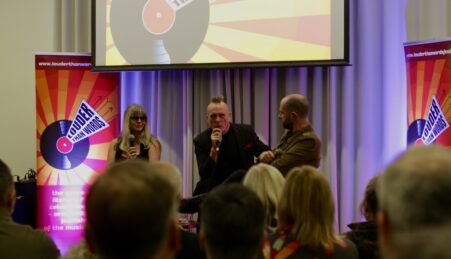Photograph: Fox Fisher
By Grace Atkinson
Award-winning campaigner, columnist and author Jack Monroe delivered a thought-provoking lecture on the effects and safeguarding of ‘fake news’ at Manchester Met this week. The lecture, held as part of the ‘Engaging the Humanities’ unit, offered an honest insight into the toll fake news has had on the news industry, and how Monroe tackles its effects as both writer and reader.
Jack Monroe came into the public eye following the popularity of her blog ‘Cooking on a Bootstrap’, followed by her book A Girl Called Jack: 100 Delicious Budget Recipes, which gave recipes for nutritious, family meals for less than £10 a week, taken from her own experience as a struggling single parent.
Monroe has since released several books of ‘austerity recipes’, and has become an important figure in various UK campaigns against poverty and hunger. Monroe has written regular columns for The Guardian, The New Yorker, The Echo and Huffington Post. Monroe began her lecture by illuminating some of the ways an article can fall under the category of ‘fake news’, using Claire Wardle’s frame of ‘seven types of misinformation and disinformation’.
Monroe explained these stages in order of severity, starting with satire and parody news sites, where she stressed the importance of appropriately critiquing what is read, and in engaging with original sources. She commented, “We start off with things like The Onion and The Daily Mash, that’s step one, that’s your entry-level-fake-news-drugs, and then you start to go down and down and down.”
Following this was ‘false connection’ articles, which bear a fake, eye-grabbing headline that does not correlate with its factual content, and ‘misleading content’, which involves a journalist or PR company’s twist on a story to fit their own agenda. This isn’t to be confused with ‘false context’, which frames true content in a false context. ‘Imposter content’ is when an untrustworthy, independent source seeks to disguise itself as a well-established one, using professional looking names and layouts.
Monroe described her own personal experience with ‘imposter content’, when Mathew Steeples, Editor-in-Chief of The Steeple Times, posted a fake article posing as a factual news piece during the early stages of her popularity, claiming various falsities about the author. “I was horrified” she said, before explaining that how this had affected her. “You look at that and it’s the same emotional impact that it would be to read those things about yourself in a newspaper, because it’s presented in a professional manner, in a typeface you’re familiar with, in a setting that should be preserved just for fact, for truth.”
Monroe expressed a particular concern when it came to ‘manipulated content’, explaining how “doctored images can tell any story that anybody wants it to tell.” She explained, “We retain those [images] much more firmly, and they’re much more difficult to shake out of our subconscious, and out of our psyche. They are much more effective ways of shaping people’s belief systems”. This was a poignant message, reminding the audience how most people relying heavily on images as a quick and easy way to absorb content, making us less likely to seek any factual backup.
The seventh stage of fake news was ‘fabricated content’, which felt pleasantly simple after the complex stages prior to it. Monroe reminded us of her first-hand trouble with ‘fabricated content’, in 2016, when she sued controversial columnist Katie Hopkins for falsely accusing her on Twitter of defacing a World War II memorial.
‘Fake news’ has become an epidemic of 2017, as Monroe explained how “news is given equal weight, and equal prominence on search engines and social media regardless of its source”. She then explained that 20 of the most shared news stories are from ‘fake news’ sites, and that those sites received a lot more traffic than reputable ones. She added, “That’s what we’re up against. Fake news has now overtaken the real news.”
In 2016, Facebook promised to flag-up fake news sites, but delivering ‘fake news’ has become a profession, one that can harvest a big income. She said, “We live in an era where clicks and shares can be monetised and people are cashing in on that.” Because of this, it’s unlikely ‘fake news’ will be quashed easily, so Monroe gave a checklist for readers and writers in the room, to make sure that they aren’t being permeated by it, but even more importantly, they aren’t contributing to it.
Most importantly was not to exaggerate your own work, despite how tempting it is to embellish a story, and to recognise an article that is exaggerated. This can be done simply by recognising punctuation, such as the use of exclamation marks, which sets off alarm bells for Monroe. Secondly, Monroe explained that it was fundamental to ‘triple source’ news, “Before I tweet about anything, before I write about anything, before I put my name to anything, because you’re only as good as your worst opinion. I try to triple source everything.”
Monroe then recognised the importance of not sharing fake news articles. “It’s not hyper-bomb to say that sharing deliberately false information, even for a laugh, ends up with grown men standing with machine guns in pizza shops”, in a clear reference to the US Pizzagate scandal in 2016. She said, “You gradually chip away at people’s belief systems, you make them paranoid, they question everything they know about the world, about their lives, and about themselves, and once you’ve achieved that, you can tell them anything.”
It is also useful to check the website you’re reading. Monroe explained that it is a current trend for news sites to very slightly alter the spelling of another, reputable website address, as a way to trick its readers. Finally, and most poignantly, Monroe encouraged us to use our own instinct. To ask ourselves if what we are reading seems genuinely feasible, and to fully engage with the page in front of us in relation to the world around us.
Monroe ended her lecture by going back to her legal quarrel with Katie Hopkins, where her barrister, Jonathan Price’s defence was that Twitter was a so-called ‘Wild West’ of accusations, and that “nobody ever actually believed what they read on it”. In the case, Price lost £24,000 to Monroe, and £350,000 in legal fees. “Twitter is not a ‘Wild West,” said Monroe. “You can’t say what you like, and enough people believed Katie’s claim that I defaced the war memorial, that I received over 20 separate death threats over it”. Monroe went on to explain, “Fake news does have a cost. It does have a price. That price is very often a human price and clicking on it and sharing it might look like fun, and might be a bit of a laugh, but actually it’s a breadcrumb trail that leads to people being genuinely hurt.”





Leave a reply